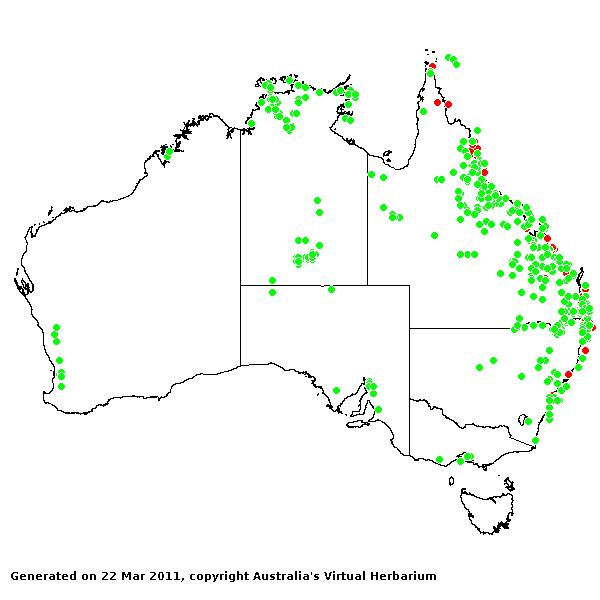Melinis* Essai Agrost. 54 (1812).
Derivation:. From Greek meline (grain), derivation uncertain.
Taxonomic revisions, nomenclatural references:. G.Zizka, Biblioth. Bot. 138: 1–149 (1988).
Key references (keys and floras):. C.A.Gardner, Flora of Western Australia 1 Gramineae 274–276 (1952), and 274 (as Rhynchelytrum); E.E.Henty, Manual Grasses New Guinea 124 (1969) and 166 (as Rhyncheltrum); J.W.Vickery, Flora of New South Wales, Gramineae 19: 219–220 (1975) as Rhynchelytrum; M.Lazarides, Tropical Grasses S.E. Asia 123–124 and138 (as Rhynchelytrum) (1980); M.Lazarides, Flora of Central Australia 481 (1981) as Rhynchelytrum; J.C.Tothill and J.B.Hacker, Grasses of Southern Queensland 304–305(1983) and 362–363 (as Rhynchelytrum); J.P.Jessop, Flora of South Australia 4: 1976(1986) as Rhynchelytrum; T.D.Macfarlane, Flora of the Kimberley Region 1188 (1992); B.K.Simon, Key to Australian Grasses 130 (1993); S.W.L.Jacobs and K.L.McClay, Flora of New South Wales 4: 492 (1993); N.G.Walsh, Flora of Victoria 2: 605 (1994); D.Sharp and B.K.Simon, AusGrass (2002); J.P.Jessop, Grasses of South Australia 454–456 (2006); S.W.L.Jacobs, R.D.B.Whalley & D.J.B.Wheeler, Grasses of New South Wales, 4th ed, 299–300 (2008).
W.D.Clayton & S.A.Renvoize, Genera Graminum (1986), genus (516, 517).
Naturalised. 23 species, from tropical South America and West Indies (1); tropical and South Africa, Madagascar (17). 2 species in Australia, WA, NT, SA, Qld, NSW, and Vic. Also New Guinea and Malesia.
Habit. Annual or perennial, decumbent. Leaf blades narrow. Ligule a fringed membrane (very narrow) or a fringe of hairs.
Inflorescence. Inflorescence paniculate, an open panicle with branches ending in single spikelets, open.
Spikelets. Spikelets subterete to dorsally compressed, 2 flowered, with 1 fertile floret, awned, solitary, pedicelled. Fertile spikelets with lower incomplete floret(s), oblong, falling with glumes.
Glumes. Glumes one per spikelet or two, unequal, (the upper) long relative to adjacent lemmas, awned or awnless, dissimilar (the lower tiny, membranous or reduced to a rim, the upper equalling spikelet, truncate, emarginate or bifid at summit, often awned from the sinus, straight on the back). Lower glume 0 nerved. Upper glume 7 nerved.
Florets. Lower incomplete floret(s) male, or sterile. Lemmas awned (usually, with a subulate awn from the bifid apex) or awnless (rarely), 3–5 nerved, similar in texture to fertile lemmas or decidedly firmer than fertile lemmas, not becoming indurated. Fertile florets 1. Lemmas less firm than glumes (hyaline or thinly membranous), smooth, not becoming indurated, white in fruit, entire at apex or incised, muticous, without a germination flap, 1–3 nerved, glabrous, having flat margins not tucked into palea, 1 keeled. Palea relatively long, textured like lemma, 2 nerved, not keeled (or flattened). Lodicules 2. Stamens 3. Hilum short. Embryo large.
Kranz Anatomy. C4, biochemical type PCK (M. minutiflora).
2n = 36, commonly adventive.
Habitat. Helophytic, mesophytic. Savanna woodland, open grassland and disturbed ground. Shade species and species of open habitats.
Classification. Panicoideae; Paniceae (Melinideae).
Notes. A homogeneous genus of barely distinct species. It includes Rhynchelytrum, although the two "genera" differ in spikelet shape (Clayton and Renvoize, 1986).
Types Species. M. minutiflora P.Beauv.
Biogeographic Element. Clifford & Simon 1981, Simon & Jacobs 1990: Naturalised.


